2022 NISSAN LEAF ECU
[x] Cancel search: ECUPage 126 of 618
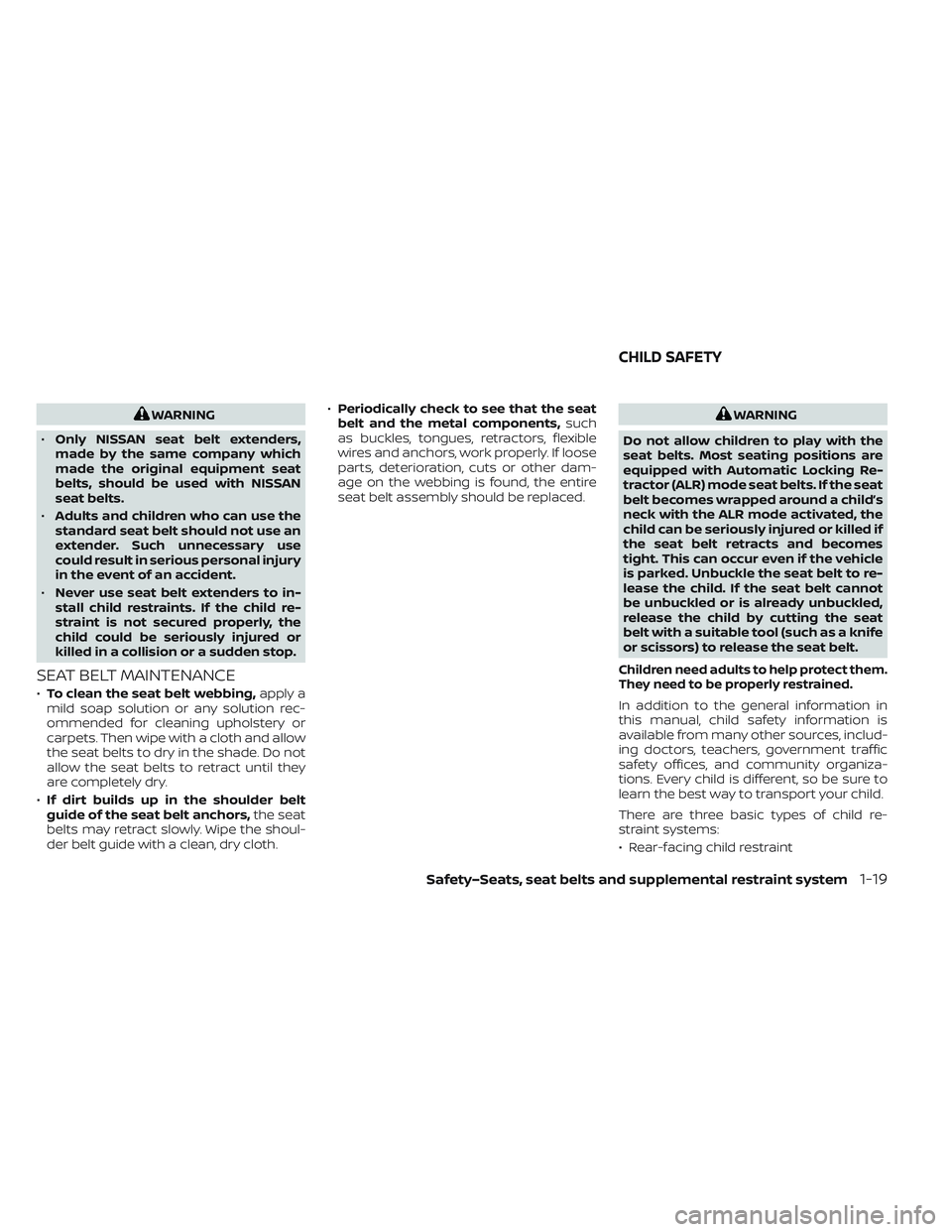
WARNING
• Only NISSAN seat belt extenders,
made by the same company which
made the original equipment seat
belts, should be used with NISSAN
seat belts.
• Adults and children who can use the
standard seat belt should not use an
extender. Such unnecessary use
could result in serious personal injury
in the event of an accident.
• Never use seat belt extenders to in-
stall child restraints. If the child re-
straint is not secured properly, the
child could be seriously injured or
killed in a collision or a sudden stop.
SEAT BELT MAINTENANCE
• To clean the seat belt webbing, apply a
mild soap solution or any solution rec-
ommended for cleaning upholstery or
carpets. Then wipe with a cloth and allow
the seat belts to dry in the shade. Do not
allow the seat belts to retract until they
are completely dry.
• If dirt builds up in the shoulder belt
guide of the seat belt anchors, the seat
belts may retract slowly. Wipe the shoul-
der belt guide with a clean, dry cloth. •
Periodically check to see that the seat
belt and the metal components, such
as buckles, tongues, retractors, flexible
wires and anchors, work properly. If loose
parts, deterioration, cuts or other dam-
age on the webbing is found, the entire
seat belt assembly should be replaced.
WARNING
Do not allow children to play with the
seat belts. Most seating positions are
equipped with Automatic Locking Re-
tractor (ALR) mode seat belts. If the seat
belt becomes wrapped around a child’s
neck with the ALR mode activated, the
child can be seriously injured or killed if
the seat belt retracts and becomes
tight. This can occur even if the vehicle
is parked. Unbuckle the seat belt to re-
lease the child. If the seat belt cannot
be unbuckled or is already unbuckled,
release the child by cutting the seat
belt with a suitable tool (such as a knife
or scissors) to release the seat belt.
Children need adults to help protect them.
They need to be properly restrained.
In addition to the general information in
this manual, child safety information is
available from many other sources, includ-
ing doctors, teachers, government traffic
safety offices, and community organiza-
tions. Every child is different, so be sure to
learn the best way to transport your child.
There are three basic types of child re-
straint systems:
• Rear-facing child restraint
CHILD SAFETY
Safety–Seats, seat belts and supplemental restraint system1-19
Page 127 of 618

• Forward-facing child restraint
• Booster seat
The proper restraint depends on the child’s
size. Generally, infants up to about 1 year
and less than 20 lbs. (9 kg) should be placed
in rear-facing child restraints. Forward-
facing child restraints are available for chil-
dren who outgrow rear-facing child re-
straints and are at least 1 year old. Booster
seats are used to help position a vehicle
lap/shoulder belt on a child who can no
longer use a forward-facing child restraint.
WARNING
Infants and children need special pro-
tection. The vehicle’s seat belts may
not fit them properly. The shoulder belt
may come too close to the face or neck.
The lap belt may not fit over their small
hip bones. In an accident, an improp-
erly fitting seat belt could cause serious
or fatal injury. Always use appropriate
child restraints.
All U.S. states and Canadian provinces or
territories require the use of approved child
restraints for infants and small children.
For additional information, see “Child re-
straints” (P. 1-22). A child restraint may be secured in the ve-
hicle by using either the LATCH (Lower An-
chor and Tethers for CHildren) system or
with the vehicle seat belt. For additional
information, see “Child restraints” (P. 1-22).
NISSAN recommends that all pre-teens
and children be restrained in the rear
seat. According to accident statistics,
children are safer when properly re-
strained in the rear seat than in the front
seat.
This is especially important because
your vehicle has a supplemental re-
straint system (air bag system) for the
front passenger. For additional informa-
tion, see “Supplemental Restraint Sys-
tem (SRS)” (P. 1-45).
INFANTS
Infants up to at least 1 year old should be
placed in a rear-facing child restraint.
NISSAN recommends that infants be
placed in child restraints that comply with
Federal Motor Vehicle Safety Standards or
Canadian Motor Vehicle Safety Standards.
You should choose a child restraint that fits
your vehicle and always follow the manu-
facturer’s instructions for installation and
use.
SMALL CHILDREN
Children that are over 1 year old and weigh
at least 20 lbs. (9 kg) should remain in a
rear-facing child restraint as long as pos-
sible up to the height or weight limit of the
child restraint. Children who outgrow the
height or weight limit of the rear-facing
child restraint and are at least 1 year old
should be secured in a forward-facing child
restraint with a harness. Refer to the manu-
facturer’s instructions for minimum and
maximum weight and height recommen-
dations. NISSAN recommends that small
children be placed in child restraints that
comply with Federal Motor Vehicle Safety
Standards or Canadian Motor Vehicle
Safety Standards. You should choose a
child restraint that fits your vehicle and al-
ways follow the manufacturer’s instruc-
tions for installation and use.
LARGER CHILDREN
Children should remain in a forward-facing
child restraint with a harness until they reach
the maximum height or weight limit allowed
by the child restraint manufacturer.
1-20Safety–Seats, seat belts and supplemental restraint system
Page 130 of 618

–Infants and children should never
be held on anyone's lap. Even the
strongest adult cannot resist the
forces of a collision.
– Do not put a seat belt around both
a child and another passenger.
– NISSAN recommends that all child
restraints be installed in the rear
seat. Studies show that children
are safer when properly re-
strained in the rear seat than in
the front seat. If you must install a
forward-facing child restraint in
the front seat, see “Forward-
facing child restraint installation
using the seat belts” (P. 1-36).
– Even with the NISSAN Advanced
Air Bag System, never install a
rear-facing child restraint in the
front seat. An inflating air bag
could seriously injure or kill a child.
A rear-facing child restraint must
only be used in the rear seat.
– Be sure to purchase a child re-
straint that will fit the child and
vehicle. Some child restraints may
not fit properly in your vehicle. –Child restraint anchorages are de-
signed to withstand only those
loads imposed by correctly fitted
child restraints. Under no circum-
stances are they to be used to at-
tach adult seat belts, or other items
or equipment to the vehicle. Doing
so could damage the child restraint
anchorages. The child restraint will
not be properly installed using the
damaged anchorage, and a child
could be seriously injured or killed
in a collision.
–
Never use the anchor points for
adult seat belts or other items.
– A child restraint with a top tether
strap should not be used in the
front passenger seat.
–
Keep seatbacks as upright as pos-
sible af ter fitting the child restraint.
– Infants and children should al-
ways be placed in an appropriate
child restraint while in the vehicle.
• When the child restraint is not in use,
keep it secured with the LATCH sys-
tem or a seat belt. In a sudden stop or
collision, loose objects can injure oc-
cupants or damage the vehicle.
CAUTION
A child restraint in a closed vehicle can
become very hot. Check the seating
surface and buckles before placing a
child in the child restraint.
This vehicle is equipped with a universal
child restraint anchor system, referred to
as the LATCH (Lower Anchors and Tethers
for CHildren) system. Some child restraints
include rigid or webbing-mounted attach-
ments that can be connected to these
anchors.
For additional information, see “LATCH
(Lower Anchors and Tethers for CHildren)
system” (P. 1-24).
If you do not have a LATCH compatible
child restraint, the vehicle seat belts can be
used.
Several manufacturers offer child re-
straints for infants and small children of
various sizes. When selecting any child re-
straint, keep the following points in mind:
• Choose only a restraint with a label certi- f ying that it complies with Federal Motor
Vehicle Safety Standard 213 or Canadian
Motor Vehicle Safety Standard 213.
Safety–Seats, seat belts and supplemental restraint system1-23
Page 131 of 618
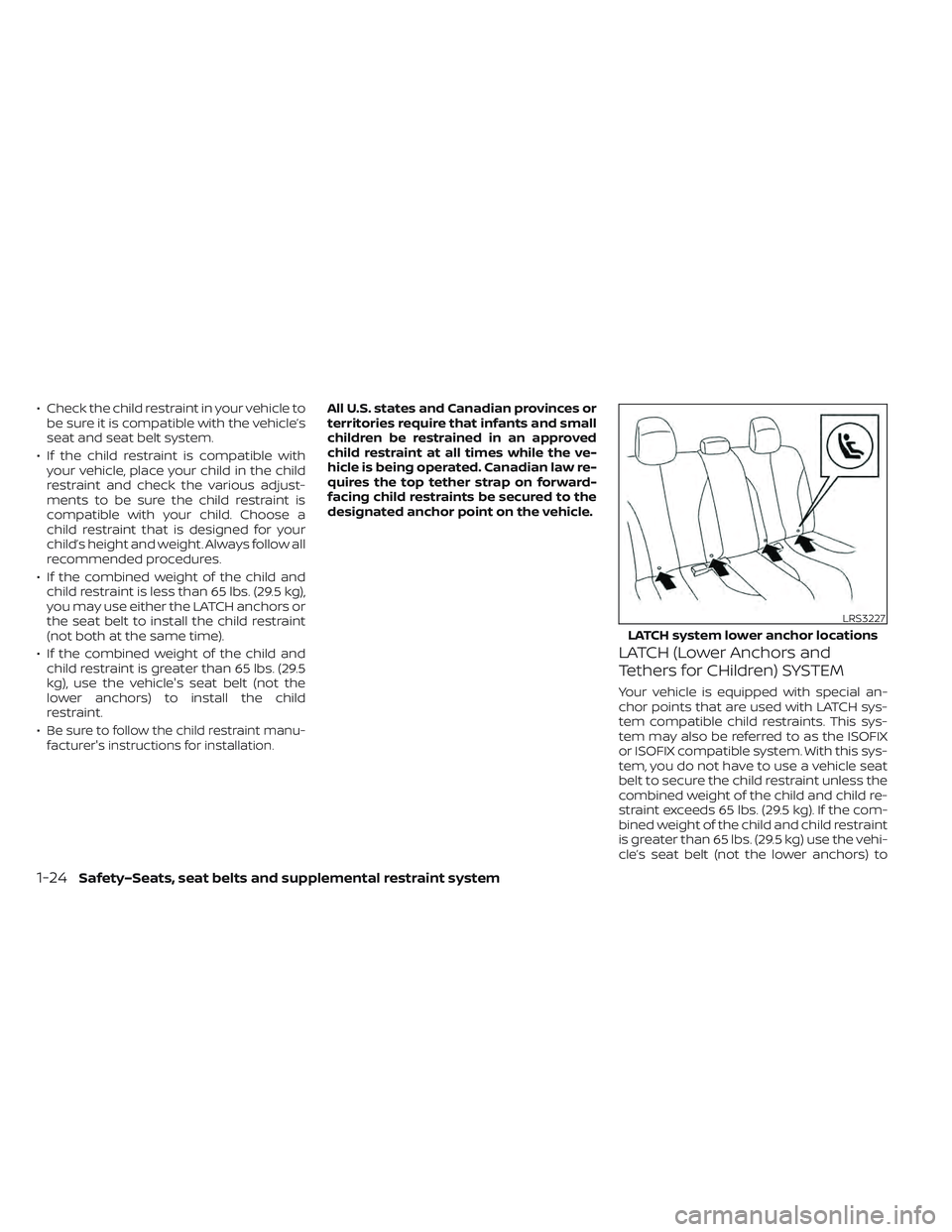
• Check the child restraint in your vehicle tobe sure it is compatible with the vehicle’s
seat and seat belt system.
• If the child restraint is compatible with your vehicle, place your child in the child
restraint and check the various adjust-
ments to be sure the child restraint is
compatible with your child. Choose a
child restraint that is designed for your
child’s height and weight. Always follow all
recommended procedures.
• If the combined weight of the child and child restraint is less than 65 lbs. (29.5 kg),
you may use either the LATCH anchors or
the seat belt to install the child restraint
(not both at the same time).
• If the combined weight of the child and child restraint is greater than 65 lbs. (29.5
kg), use the vehicle's seat belt (not the
lower anchors) to install the child
restraint.
•
Be sure to follow the child restraint manu-
facturer's instructions for installation.
All U.S. states and Canadian provinces or
territories require that infants and small
children be restrained in an approved
child restraint at all times while the ve-
hicle is being operated. Canadian law re-
quires the top tether strap on forward-
facing child restraints be secured to the
designated anchor point on the vehicle.
LATCH (Lower Anchors and
Tethers for CHildren) SYSTEM
Your vehicle is equipped with special an-
chor points that are used with LATCH sys-
tem compatible child restraints. This sys-
tem may also be referred to as the ISOFIX
or ISOFIX compatible system. With this sys-
tem, you do not have to use a vehicle seat
belt to secure the child restraint unless the
combined weight of the child and child re-
straint exceeds 65 lbs. (29.5 kg). If the com-
bined weight of the child and child restraint
is greater than 65 lbs. (29.5 kg) use the vehi-
cle’s seat belt (not the lower anchors) to
LRS3227
LATCH system lower anchor locations
1-24Safety–Seats, seat belts and supplemental restraint system
Page 132 of 618
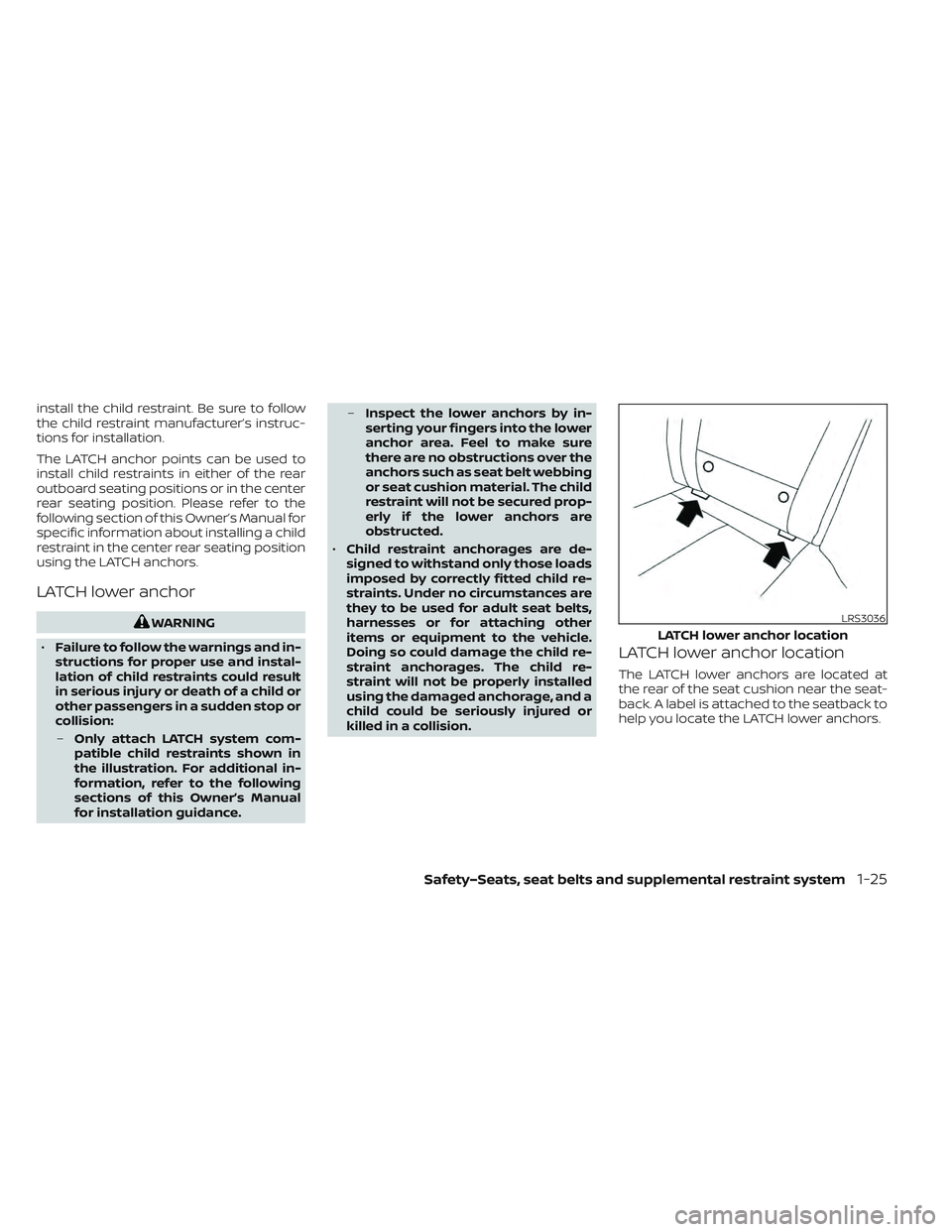
install the child restraint. Be sure to follow
the child restraint manufacturer’s instruc-
tions for installation.
The LATCH anchor points can be used to
install child restraints in either of the rear
outboard seating positions or in the center
rear seating position. Please refer to the
following section of this Owner’s Manual for
specific information about installing a child
restraint in the center rear seating position
using the LATCH anchors.
LATCH lower anchor
WARNING
• Failure to follow the warnings and in-
structions for proper use and instal-
lation of child restraints could result
in serious injury or death of a child or
other passengers in a sudden stop or
collision:
– Only attach LATCH system com-
patible child restraints shown in
the illustration. For additional in-
formation, refer to the following
sections of this Owner’s Manual
for installation guidance. –
Inspect the lower anchors by in-
serting your fingers into the lower
anchor area. Feel to make sure
there are no obstructions over the
anchors such as seat belt webbing
or seat cushion material. The child
restraint will not be secured prop-
erly if the lower anchors are
obstructed.
• Child restraint anchorages are de-
signed to withstand only those loads
imposed by correctly fitted child re-
straints. Under no circumstances are
they to be used for adult seat belts,
harnesses or for attaching other
items or equipment to the vehicle.
Doing so could damage the child re-
straint anchorages. The child re-
straint will not be properly installed
using the damaged anchorage, and a
child could be seriously injured or
killed in a collision.
LATCH lower anchor location
The LATCH lower anchors are located at
the rear of the seat cushion near the seat-
back. A label is attached to the seatback to
help you locate the LATCH lower anchors.
LRS3036
LATCH lower anchor location
Safety–Seats, seat belts and supplemental restraint system1-25
Page 133 of 618
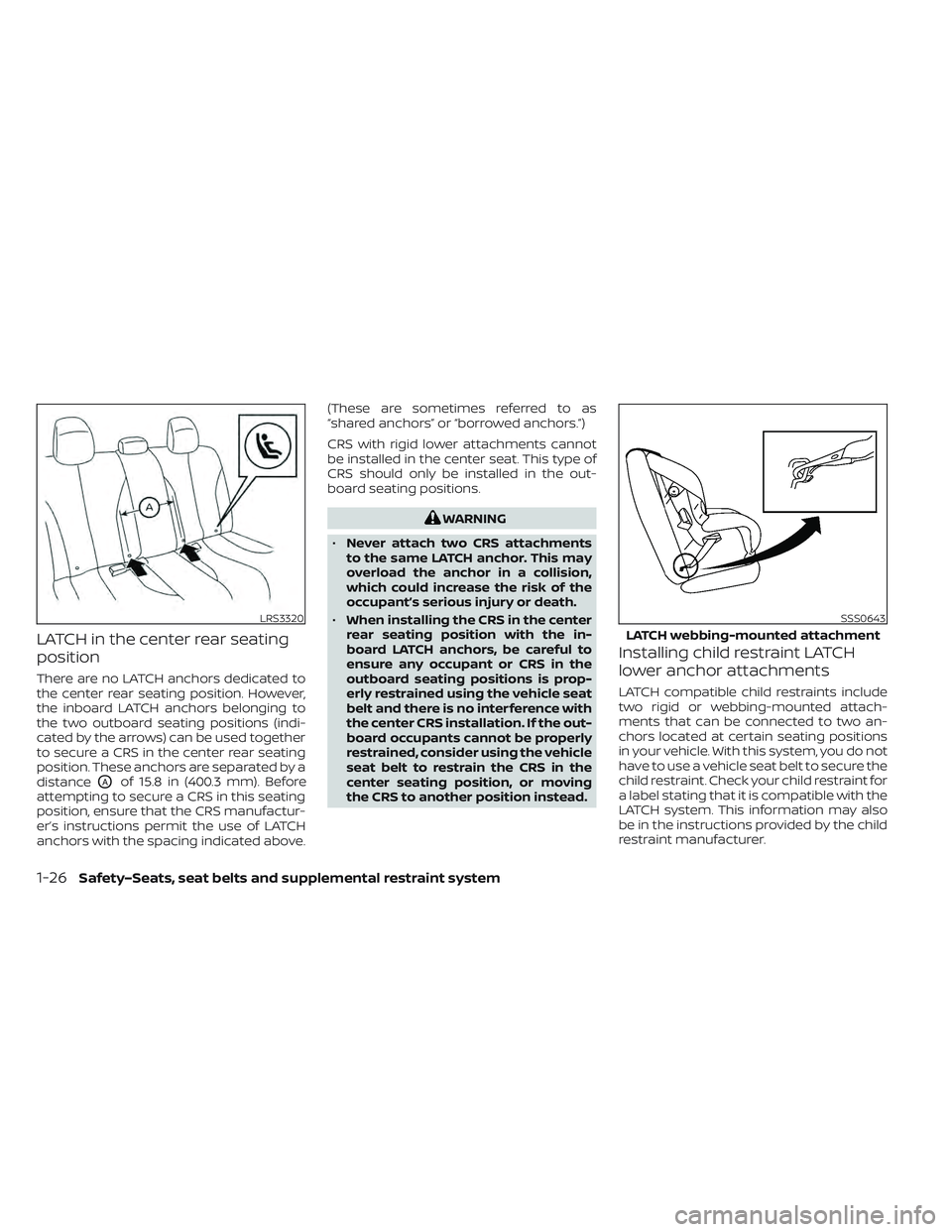
LATCH in the center rear seating
position
There are no LATCH anchors dedicated to
the center rear seating position. However,
the inboard LATCH anchors belonging to
the two outboard seating positions (indi-
cated by the arrows) can be used together
to secure a CRS in the center rear seating
position. These anchors are separated by a
distance
OAof 15.8 in (400.3 mm). Before
attempting to secure a CRS in this seating
position, ensure that the CRS manufactur-
er’s instructions permit the use of LATCH
anchors with the spacing indicated above. (These are sometimes referred to as
“shared anchors” or “borrowed anchors.”)
CRS with rigid lower attachments cannot
be installed in the center seat. This type of
CRS should only be installed in the out-
board seating positions.
WARNING
• Never attach two CRS attachments
to the same LATCH anchor. This may
overload the anchor in a collision,
which could increase the risk of the
occupant’s serious injury or death.
• When installing the CRS in the center
rear seating position with the in-
board LATCH anchors, be careful to
ensure any occupant or CRS in the
outboard seating positions is prop-
erly restrained using the vehicle seat
belt and there is no interference with
the center CRS installation. If the out-
board occupants cannot be properly
restrained, consider using the vehicle
seat belt to restrain the CRS in the
center seating position, or moving
the CRS to another position instead.
Installing child restraint LATCH
lower anchor attachments
LATCH compatible child restraints include
two rigid or webbing-mounted attach-
ments that can be connected to two an-
chors located at certain seating positions
in your vehicle. With this system, you do not
have to use a vehicle seat belt to secure the
child restraint. Check your child restraint for
a label stating that it is compatible with the
LATCH system. This information may also
be in the instructions provided by the child
restraint manufacturer.
LRS3320SSS0643
LATCH webbing-mounted attachment
1-26Safety–Seats, seat belts and supplemental restraint system
Page 134 of 618
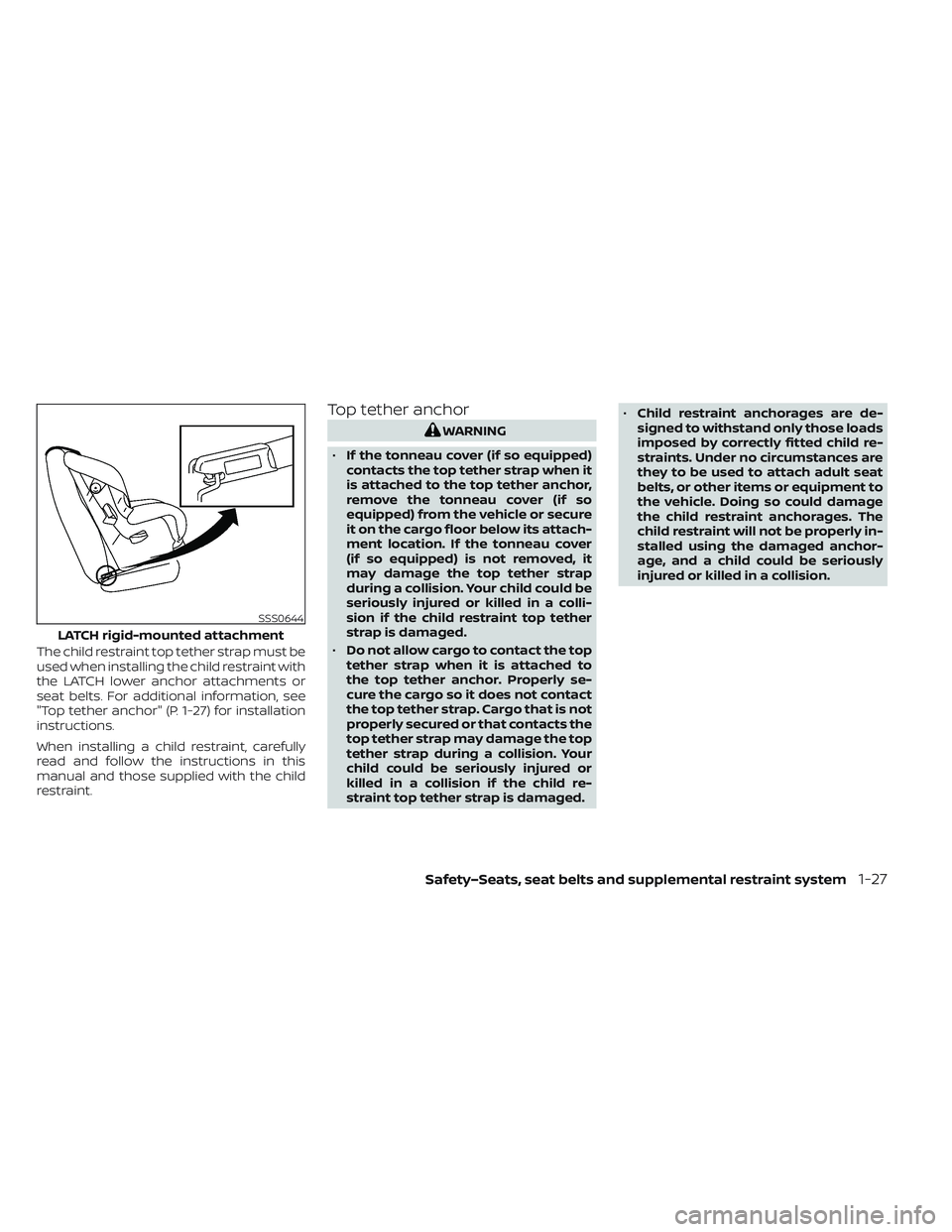
The child restraint top tether strap must be
used when installing the child restraint with
the LATCH lower anchor attachments or
seat belts. For additional information, see
"Top tether anchor" (P. 1-27) for installation
instructions.
When installing a child restraint, carefully
read and follow the instructions in this
manual and those supplied with the child
restraint.
Top tether anchor
WARNING
• If the tonneau cover (if so equipped)
contacts the top tether strap when it
is attached to the top tether anchor,
remove the tonneau cover (if so
equipped) from the vehicle or secure
it on the cargo floor below its attach-
ment location. If the tonneau cover
(if so equipped) is not removed, it
may damage the top tether strap
during a collision. Your child could be
seriously injured or killed in a colli-
sion if the child restraint top tether
strap is damaged.
• Do not allow cargo to contact the top
tether strap when it is attached to
the top tether anchor. Properly se-
cure the cargo so it does not contact
the top tether strap. Cargo that is not
properly secured or that contacts the
top tether strap may damage the top
tether strap during a collision. Your
child could be seriously injured or
killed in a collision if the child re-
straint top tether strap is damaged. •
Child restraint anchorages are de-
signed to withstand only those loads
imposed by correctly fitted child re-
straints. Under no circumstances are
they to be used to attach adult seat
belts, or other items or equipment to
the vehicle. Doing so could damage
the child restraint anchorages. The
child restraint will not be properly in-
stalled using the damaged anchor-
age, and a child could be seriously
injured or killed in a collision.
SSS0644
LATCH rigid-mounted attachment
Safety–Seats, seat belts and supplemental restraint system1-27
Page 135 of 618
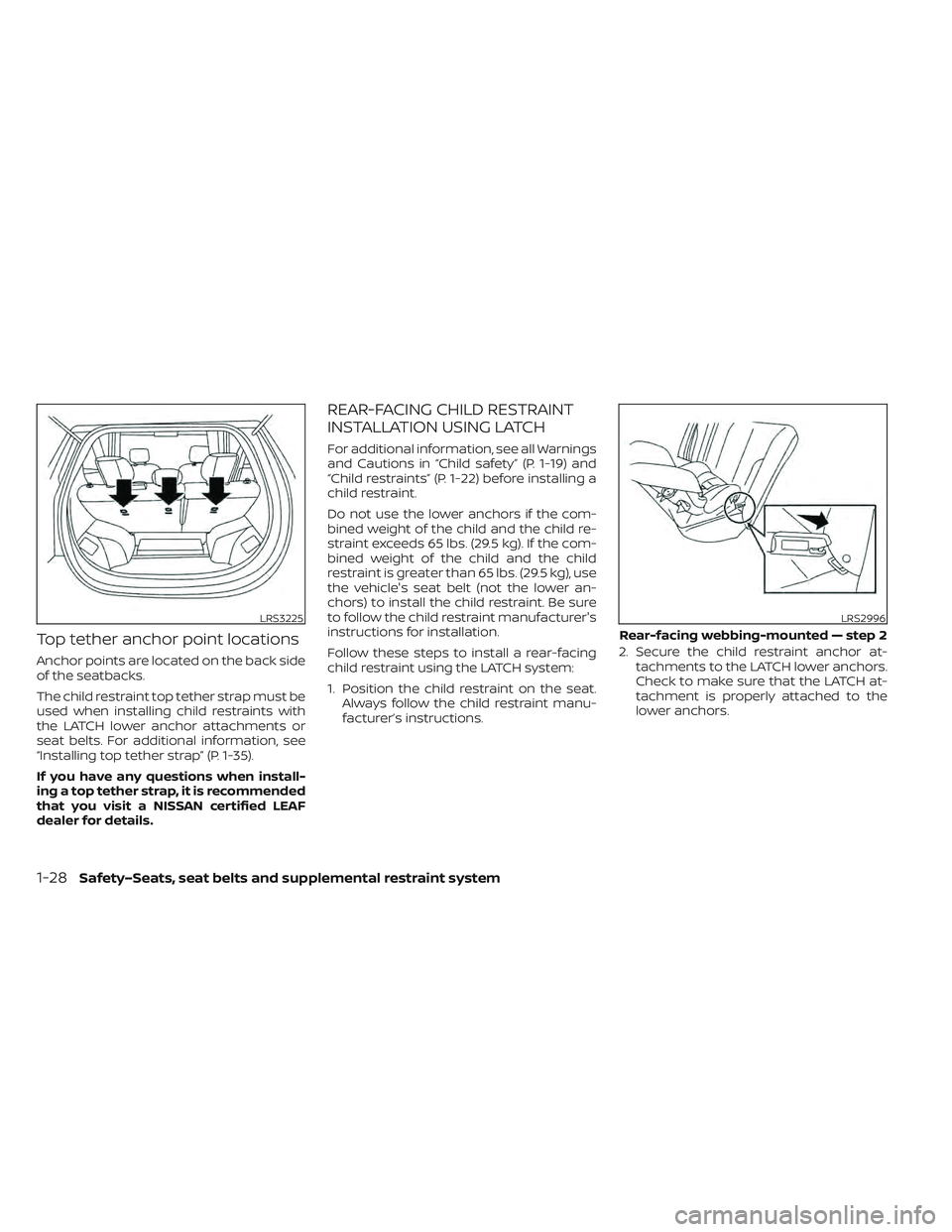
Top tether anchor point locations
Anchor points are located on the back side
of the seatbacks.
The child restraint top tether strap must be
used when installing child restraints with
the LATCH lower anchor attachments or
seat belts. For additional information, see
“Installing top tether strap” (P. 1-35).
If you have any questions when install-
ing a top tether strap, it is recommended
that you visit a NISSAN certified LEAF
dealer for details.
REAR-FACING CHILD RESTRAINT
INSTALLATION USING LATCH
For additional information, see all Warnings
and Cautions in “Child safety” (P. 1-19) and
“Child restraints” (P. 1-22) before installing a
child restraint.
Do not use the lower anchors if the com-
bined weight of the child and the child re-
straint exceeds 65 lbs. (29.5 kg). If the com-
bined weight of the child and the child
restraint is greater than 65 lbs. (29.5 kg), use
the vehicle's seat belt (not the lower an-
chors) to install the child restraint. Be sure
to follow the child restraint manufacturer's
instructions for installation.
Follow these steps to install a rear-facing
child restraint using the LATCH system:
1. Position the child restraint on the seat.Always follow the child restraint manu-
facturer’s instructions. 2. Secure the child restraint anchor at-
tachments to the LATCH lower anchors.
Check to make sure that the LATCH at-
tachment is properly attached to the
lower anchors.
LRS3225LRS2996
Rear-facing webbing-mounted — step 2
1-28Safety–Seats, seat belts and supplemental restraint system